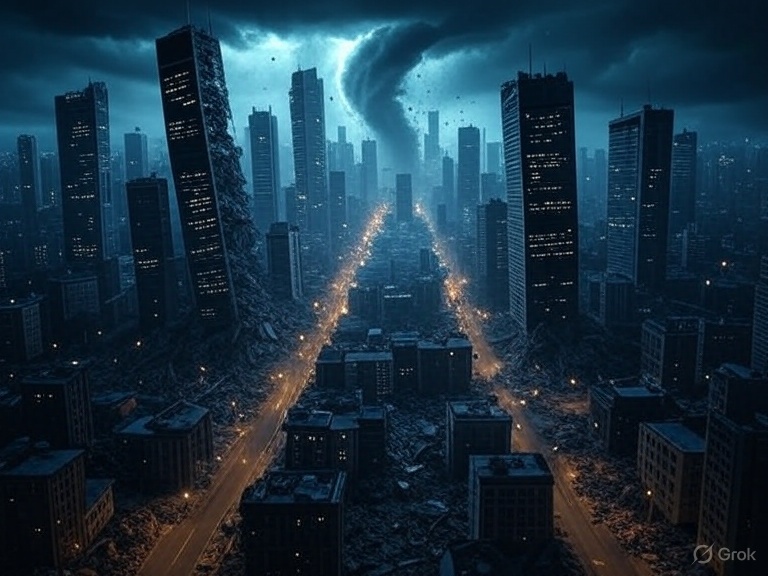Earthquakes are among nature’s most devastating forces, capable of leveling cities, reshaping landscapes, and altering the course of human history. Usually, quakes of magnitude 7.0 or higher are rare, occurring only a handful of times each year worldwide. But imagine a world where such massive tremors happened every single day across the globe. How would our planet, environment, and civilization change under this relentless seismic assault?
Understanding the Power of Magnitude 7.0 Quakes
On the Richter scale, a 7.0 earthquake releases energy equivalent to about 32 megatons of TNT — more than 2,000 times stronger than the atomic bomb dropped on Hiroshima. These quakes can destroy poorly built structures, disrupt transportation, and trigger tsunamis if they occur offshore. In our world, they’re catastrophic but rare. In this imagined scenario, however, they would become terrifyingly routine.
The Immediate Global Impact
1. Urban Destruction
Cities would be the first casualties. Skyscrapers, highways, and underground transit systems are not built to endure daily shocks of such magnitude. Even earthquake-resistant designs in places like Japan would eventually fail after repeated stress. Major population centers could collapse into ruins within weeks.
2. Massive Casualties and Displacement
Billions of people live in seismically active zones. With daily magnitude 7.0 events, hospitals would be overwhelmed, emergency services crippled, and survivors left without shelter. The global refugee crisis would dwarf anything in human history, as people fled from one devastated region to another.
3. Infrastructure Collapse
Power plants, water pipelines, communication networks, and internet cables would shatter under constant seismic pressure. Electricity and clean water would become luxuries, plunging society into chaos.

Environmental Consequences
1. Triggered Tsunamis
Frequent undersea quakes would generate daily tsunamis, devastating coastal regions and wiping out marine ecosystems. Fishing industries and coastal megacities would vanish under constant flooding.
2. Volcanic Eruptions
Earthquakes often precede volcanic activity. Daily tremors of such strength could awaken dormant volcanoes worldwide, filling the skies with ash clouds, blocking sunlight, and disrupting global climate.
3. Atmospheric Effects
The continuous release of dust, ash, and debris into the atmosphere could trigger a “seismic winter,” lowering temperatures globally, reducing crop yields, and pushing humanity toward famine.

Human Adaptation and Survival
1. Mass Migration to Stable Zones
Humanity would likely retreat to geologically stable regions with the least seismic activity, such as central Africa or Siberia. Entire nations might abandon their homelands, creating unprecedented global reshuffling of populations.
2. New Architecture and Engineering
If humanity survived long enough, new technologies would emerge to withstand constant seismic shocks. Underground bunkers, floating cities, or flexible megastructures might become the new standard. However, resources would be scarce, and innovation would struggle under the weight of constant destruction.
3. Collapse of Global Economy
Daily quakes would cripple industries, trade, and agriculture. Stock markets would vanish, currencies would lose meaning, and survival economies — bartering, resource-based systems — would dominate.
The Geological Perspective
Could Earth even sustain such relentless seismic activity? Geologists suggest that daily magnitude 7.0 quakes would mean the planet’s tectonic plates were in constant violent motion. This could signal an unstable Earth heading toward planetary-scale restructuring. Mountain ranges might rise and collapse within years, oceans might shift dramatically, and continents could fracture apart.
Cultural and Psychological Impact
1. Collapse of Civilization
Religions, cultures, and governments would face existential crises. Some might interpret the daily disasters as divine punishment, while others might see them as signs of planetary rebirth.
2. Constant Trauma
Humans are not built to live in perpetual fear. Daily quakes of such magnitude would result in widespread psychological trauma, leading to mass despair, breakdown of social order, and possibly the extinction of organized society.
Could Humanity Survive?
The harsh reality is that daily 7.0 earthquakes worldwide would make survival nearly impossible. Civilization, as we know it, would collapse within months. Survivors might endure in small, scattered communities, but the global population would shrink drastically. Eventually, Earth itself might stabilize after releasing its tectonic stress — but only after humanity had paid a heavy price.
Conclusion
Daily global earthquakes of magnitude 7.0 would push Earth into chaos and humanity to the brink of extinction. Cities would crumble, oceans would surge, volcanoes would awaken, and civilization would fall. While this scenario is purely hypothetical, it serves as a reminder of our planet’s raw power and the fragile balance that sustains life.

